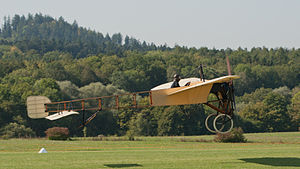
Airports for antique airplanes are aerodromes with facilities appropriate to the aircraft of the early twentieth century, including, for example, turf runways. In many cases they are collocated with aircraft museums.
Aircraft built before the end of World War I had different requirements for the landing field than modern aircraft. Modern runways are built for maximum friction. Antique aircraft, sensitive to crosswinds and often equipped with skids, benefit from a relatively slippery turf field. Aircraft museums often have turf runways to accommodate the old aircraft.
Examples
Examples include the following:
- Old Rhinebeck Aerodrome
- Antiquers Aerodrome
- Bayport Aerodrome
- Old Warden Aerodrome
- Pioneer Airport
- Fantasy of Flight
- Duxford Aerodrome
- Antique Airfield
- Great War Flying Museum at Brampton-Caledon Airport
- Estonian Aviation Museum
- Classic Flyers Museum at Tauranga Airport
- Omaka Aviation Heritage Centre at Omaka Aerodrome
- Museo del Aire (Madrid) at Cuatro Vientos Airport
References
- O'Hare, Hugh (August 30, 1981). "THEY'RE FLYING IN ANOTHER ERA". New York Times. Retrieved 20 January 2018.
a few of the old-fashioned strips remain where pilots and small antique and home-built aircraft can fly in much the same manner as pilots did 50 years ago
- Hinson, Tamara (February 7, 2014). "14 best aviation museums around the world". CNN Travel. Retrieved 20 January 2018.
- Gudmundsson, Snorri (September 3, 2013). General Aviation Aircraft Design: Applied Methods and Procedures. Butterworth-Heinemann. ISBN 9780123973290. Retrieved 20 January 2018.
- Krog, Steve (November 2012). "Wind: When is it too much?" (PDF). EAA Vintage Magazine. Retrieved 20 January 2018.
... as the turf is not only quite forgiving, but also wide enough so that I can let the individual wander left or right without doing any damage to the airplane or his or her ego